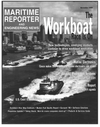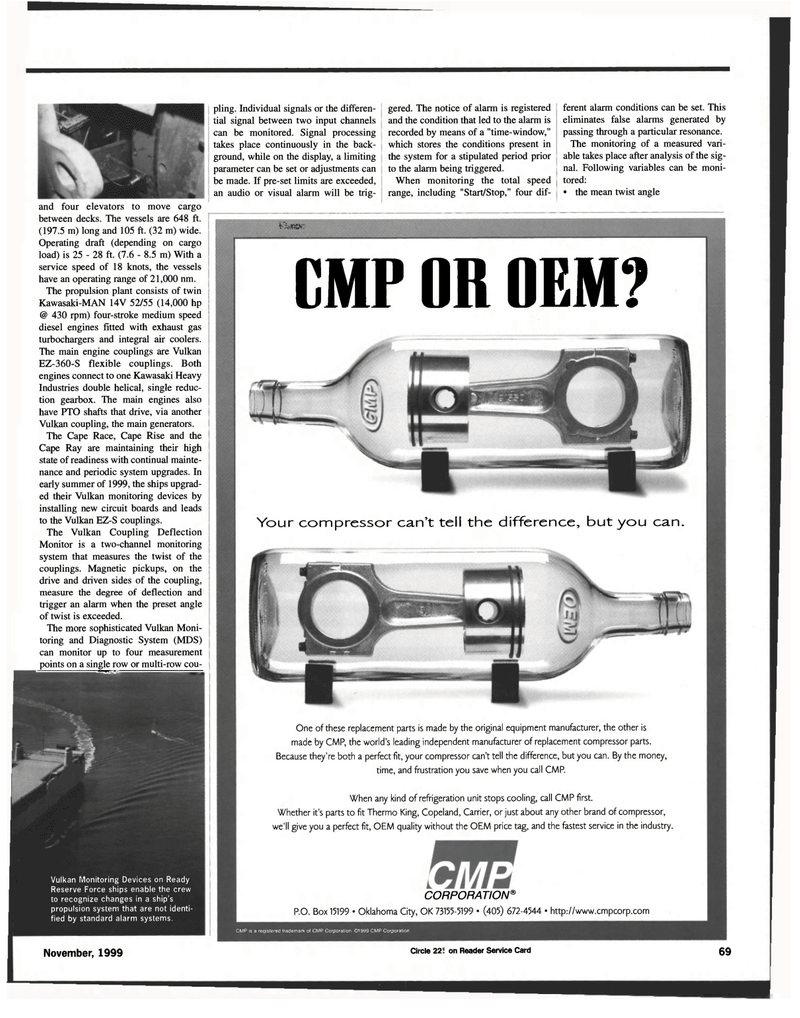
Page 73: of Maritime Reporter Magazine (November 1999)
Read this page in Pdf, Flash or Html5 edition of November 1999 Maritime Reporter Magazine
CMP is a registered trademark of CMP Corporation. ©1999 CMP Corporation and four elevators to move cargo between decks. The vessels are 648 ft. (197.5 m) long and 105 ft. (32 m) wide. Operating draft (depending on cargo load) is 25 - 28 ft. (7.6 - 8.5 m) With a service speed of 18 knots, the vessels have an operating range of 21,000 nm. The propulsion plant consists of twin Kawasaki-MAN 14V 52/55 (14,000 hp @ 430 rpm) four-stroke medium speed diesel engines fitted with exhaust gas turbochargers and integral air coolers. The main engine couplings are Vulkan EZ-360-S flexible couplings. Both engines connect to one Kawasaki Heavy Industries double helical, single reduc-tion gearbox. The main engines also have PTO shafts that drive, via another Vulkan coupling, the main generators. The Cape Race, Cape Rise and the Cape Ray are maintaining their high state of readiness with continual mainte-nance and periodic system upgrades. In early summer of 1999, the ships upgrad-ed their Vulkan monitoring devices by installing new circuit boards and leads to the Vulkan EZ-S couplings. The Vulkan Coupling Deflection Monitor is a two-channel monitoring system that measures the twist of the couplings. Magnetic pickups, on the drive and driven sides of the coupling, measure the degree of deflection and trigger an alarm when the preset angle of twist is exceeded. The more sophisticated Vulkan Moni-toring and Diagnostic System (MDS) can monitor up to four measurement points on a single row or multi-row cou-__ pling. Individual signals or the differen-tial signal between two input channels can be monitored. Signal processing takes place continuously in the back-ground, while on the display, a limiting parameter can be set or adjustments can be made. If pre-set limits are exceeded, an audio or visual alarm will be trig-gered. The notice of alarm is registered and the condition that led to the alarm is recorded by means of a "time-window," which stores the conditions present in the system for a stipulated period prior to the alarm being triggered. When monitoring the total speed range, including "Start/Stop," four dif-ferent alarm conditions can be set. This eliminates false alarms generated by passing through a particular resonance. The monitoring of a measured vari-able takes place after analysis of the sig-nal. Following variables can be moni-tored: ? the mean twist angle Vulkan Monitoring Devices on Ready Reserve Force ships enable the crew to recognize changes in a ship's propulsion system that are not identi-fied by standard alarm systems. fflamBR GMP OR OEM? One of these replacement parts is made by the original equipment manufacturer, the other is made by CMP, the world's leading independent manufacturer of replacement compressor parts. Because they're both a perfect fit, your compressor can't tell the difference, but you can. By the money, time, and frustration you save when you call CMP. When any kind of refrigeration unit stops cooling, call CMP first. Whether it's parts to fit Thermo King, Copeland, Carrier, or just about any other brand of compressor, we'll give you a perfect fit, OEM quality without the OEM price tag, and the fastest service in the industry. CORPORATION® P.O. Box 15199 ? Oklahoma City, OK 73155-5199 ? (405) 672-4544 ? http://www.cmpcorp.com Your compressor can't tell the difference, but you can. November, 1999 Circle 227 on Reader Service Card 69

 72
72

 74
74
